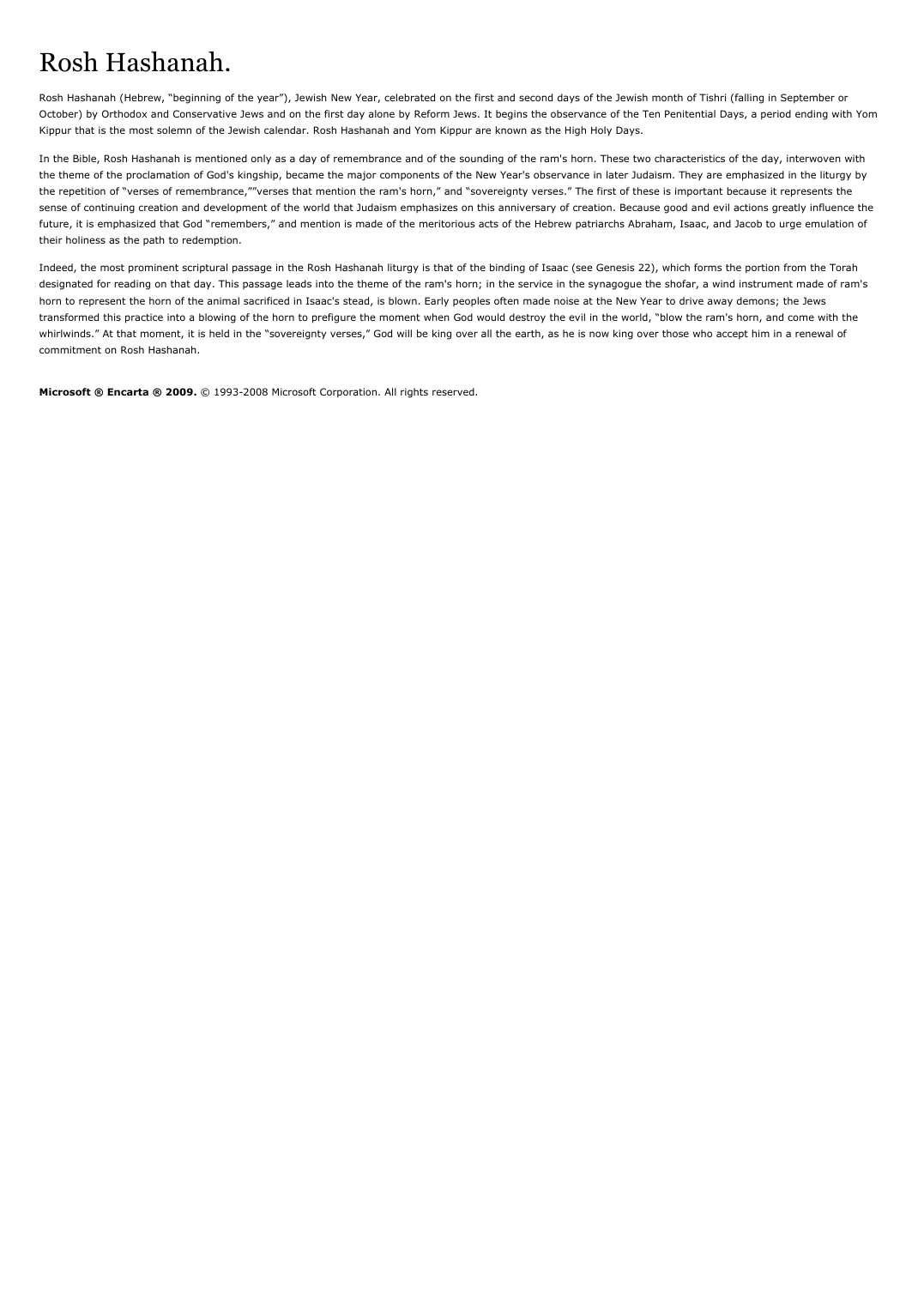Rosh Hashanah.
Publié le 06/12/2021

Extrait du document
Ci-dessous un extrait traitant le sujet : Rosh Hashanah.. Ce document contient 385 mots. Pour le télécharger en entier, envoyez-nous un de vos documents grâce à notre système d’échange gratuit de ressources numériques ou achetez-le pour la modique somme d’un euro symbolique. Cette aide totalement rédigée en format pdf sera utile aux lycéens ou étudiants ayant un devoir à réaliser ou une leçon à approfondir en : Echange
Rosh Hashanah.
Rosh Hashanah (Hebrew, "beginning of the year"), Jewish New Year, celebrated on the first and second days of the Jewish month of Tishri (falling in September or
October) by Orthodox and Conservative Jews and on the first day alone by Reform Jews. It begins the observance of the Ten Penitential Days, a period ending with Yom
Kippur that is the most solemn of the Jewish calendar. Rosh Hashanah and Yom Kippur are known as the High Holy Days.
In the Bible, Rosh Hashanah is mentioned only as a day of remembrance and of the sounding of the ram's horn. These two characteristics of the day, interwoven with
the theme of the proclamation of God's kingship, became the major components of the New Year's observance in later Judaism. They are emphasized in the liturgy by
the repetition of "verses of remembrance,""verses that mention the ram's horn," and "sovereignty verses." The first of these is important because it represents the
sense of continuing creation and development of the world that Judaism emphasizes on this anniversary of creation. Because good and evil actions greatly influence the
future, it is emphasized that God "remembers," and mention is made of the meritorious acts of the Hebrew patriarchs Abraham, Isaac, and Jacob to urge emulation of
their holiness as the path to redemption.
Indeed, the most prominent scriptural passage in the Rosh Hashanah liturgy is that of the binding of Isaac (see Genesis 22), which forms the portion from the Torah
designated for reading on that day. This passage leads into the theme of the ram's horn; in the service in the synagogue the shofar, a wind instrument made of ram's
horn to represent the horn of the animal sacrificed in Isaac's stead, is blown. Early peoples often made noise at the New Year to drive away demons; the Jews
transformed this practice into a blowing of the horn to prefigure the moment when God would destroy the evil in the world, "blow the ram's horn, and come with the
whirlwinds." At that moment, it is held in the "sovereignty verses," God will be king over all the earth, as he is now king over those who accept him in a renewal of
commitment on Rosh Hashanah.
Microsoft ® Encarta ® 2009. © 1993-2008 Microsoft Corporation. All rights reserved.
Rosh Hashanah.
Rosh Hashanah (Hebrew, "beginning of the year"), Jewish New Year, celebrated on the first and second days of the Jewish month of Tishri (falling in September or
October) by Orthodox and Conservative Jews and on the first day alone by Reform Jews. It begins the observance of the Ten Penitential Days, a period ending with Yom
Kippur that is the most solemn of the Jewish calendar. Rosh Hashanah and Yom Kippur are known as the High Holy Days.
In the Bible, Rosh Hashanah is mentioned only as a day of remembrance and of the sounding of the ram's horn. These two characteristics of the day, interwoven with
the theme of the proclamation of God's kingship, became the major components of the New Year's observance in later Judaism. They are emphasized in the liturgy by
the repetition of "verses of remembrance,""verses that mention the ram's horn," and "sovereignty verses." The first of these is important because it represents the
sense of continuing creation and development of the world that Judaism emphasizes on this anniversary of creation. Because good and evil actions greatly influence the
future, it is emphasized that God "remembers," and mention is made of the meritorious acts of the Hebrew patriarchs Abraham, Isaac, and Jacob to urge emulation of
their holiness as the path to redemption.
Indeed, the most prominent scriptural passage in the Rosh Hashanah liturgy is that of the binding of Isaac (see Genesis 22), which forms the portion from the Torah
designated for reading on that day. This passage leads into the theme of the ram's horn; in the service in the synagogue the shofar, a wind instrument made of ram's
horn to represent the horn of the animal sacrificed in Isaac's stead, is blown. Early peoples often made noise at the New Year to drive away demons; the Jews
transformed this practice into a blowing of the horn to prefigure the moment when God would destroy the evil in the world, "blow the ram's horn, and come with the
whirlwinds." At that moment, it is held in the "sovereignty verses," God will be king over all the earth, as he is now king over those who accept him in a renewal of
commitment on Rosh Hashanah.
Microsoft ® Encarta ® 2009. © 1993-2008 Microsoft Corporation. All rights reserved.
↓↓↓ APERÇU DU DOCUMENT ↓↓↓


